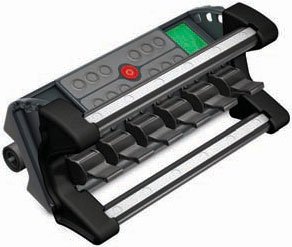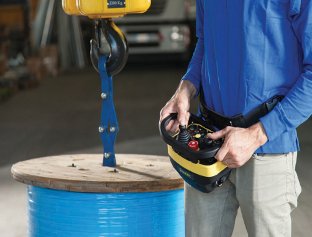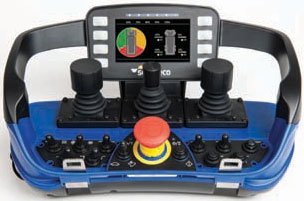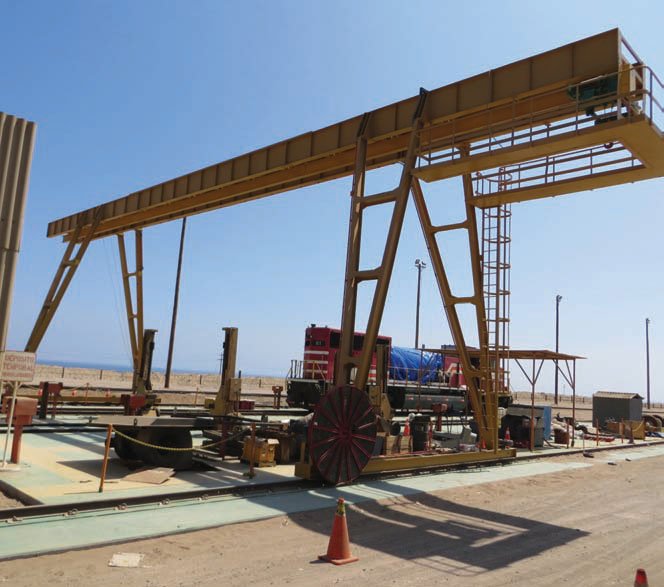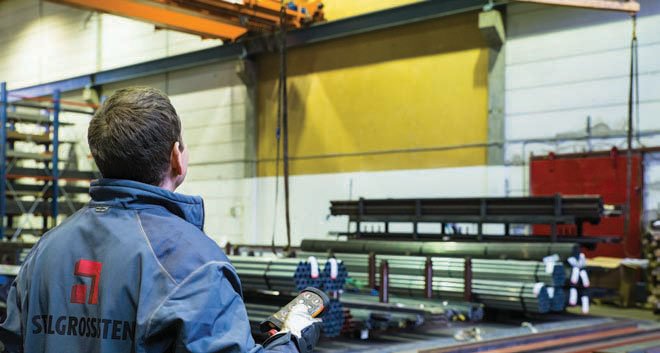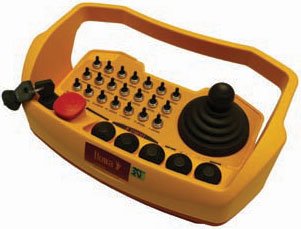The remote Part
22 February 2017Flexibility and the ability to customise systems has become one of the key features of the latest generation of crane and hoist controls.
The current generation of remote controls offer many of the same qualities as previous systems, and for good reason—robust, hard-wearing kit is always a requirement in industrial applications, and the use of the latest technology to improve the clarity and functionality of the unit’s display has always been an aim of manufacturers. And safety, as ever, remains a top priority for customers and manufacturers alike.
What’s set to become another key selling point of controls is the capacity for systems to be customised to suit the requirements and operational preferences of each customer—including the type of controls included, the function of the controls, and the data shown on the unit’s display. Scanreco’s Mini transmitters are built to be easily customised to suit customers’ requirements, says the company.
With its modular design, the Mini can accommodate between one and six linear levers or up to three joysticks, as well as several pushbuttons and switches. All controls are sized and positioned to support daily usage for many hours without causing operator fatigue, says the company.
The Maxi is Scanreco’s most advanced and versatile control, with room for multiple control elements as well as function labelling. The ergonomic housing comes in two basic versions, featuring either linear levers or joysticks, but offers a modular design that can be customised for each customer.
A range of features are included on both Mini and Maxi controls. The maximum speed of proportional movements can be adjusted using a ‘turtle/rabbit’ toggle switch in five steps. A high-performance colour display and a monochrome display or LEDs enable operator feedback from the controlled machine. And automatic frequency management allows for continuous operation without any interruptions caused by radio interference from other wireless equipment.
Scanreco has also introduced a new 4.3in colour display for both the Mini and Maxi transmitters. This incorporates a High Performance Display, designed to give excellent visibility with 16 million colours (24 bits) in outdoor and indoor environments, including in strong sunlight. An ambient light sensor optimises the display settings, while optically-bonded shock-proof glass protects the display as well as providing anti-reflection.
To enhance safety, each transmitter communicates with a corresponding receiver using a Scanreco protocol and a unique identity code. This is designed to guarantee that no other Scanreco transmitter or other product can activate function conforms to performance level “e” (PL e) as specified in EN ISO 13849-1, a standard for safety-critical components of control systems.
These transmitters are designed for heavy-duty use, says the company: “We know that our customers rely on our ability to deliver functionality they can trust—we call this Never-Stop Technology from Scanreco.” HBC-radiomatic has introduced the Technos A, a compact all-round control system for overhead cranes.
The system’s split-screen colour display shows machine data, such as load weight or hook height, and is customisable to provide the customer’s choice of information and layout. By default it includes an operating hours counter on the display, as well as other data relating to service.
The display also offers advantages when it comes to safety. When there is an impending overload, high wind speeds or other critical statuses, warning notifications are displayed automatically and the operator can react immediately.
The machine hardware can also be tailored to the customer’s needs, offering two joysticks as well as different combinations of push buttons, toggle or rotary switches.
Standard models include front panel lighting, an integrated flashlight as well as a range of HBC’s safety features. These are designed to detect situations that are dangerous to the operator—for example if the transmitter is dropped, or becomes no longer under the operator’s control—and trigger a pre-defined safety function on the machine. An optional data logger can be also provided with the Technos A controls, recording operational data to the second, says the company.
Technos A is also designed to withstand the hard daily use in industrial applications. The IP 65-rated plastic housing and the high-quality operating elements produced by HBC-radiomatic are designed to maximise the life of the controls.
To cut downtime, if the transmitter is damaged or destroyed, the operator can unplug the electronic iLOG key from the original transmitter and plug it into a spare transmitter, which is then immediately ready for use.
A high-performing Li-ion exchange battery provides the controls with more than 20 hours of continuous operating time. Tele Radio has launched the Tiger G2, the latest generation in its Tiger series. It prioritises safety, with both the stop function and two relays in the receivers approved according to the SIL3 IEC 61508 standard and PLe.
The system enables operators to control several machines from the same remote, allowing crane ID numbers to be programmed into the receiver—and all Tiger G2 transmitters can receive feedback from weight indication systems or internal feedback from the receiver’s digital inputs.
Feedback is indicated through the transmitter’s light indicators, the display or through the built-in buzzer, and can be adapted for individual requirements, says the manufacturer.
Tele Radio’s portfolio also includes the Panther series, which transmits at the widely-approved 2.4 GHz band with range up to 500m under optimal conditions. The system focuses on flexibility, with the remote control’s buttons able to be programmed to activate any relay or series of relays. Pressing just one button can start a potentially almost-unlimited chain of events, for example activating several relays with a specified amount of time in between. The relays can be assigned momentary or latching functionality, and can be set to interlock to suit the specific requirements of the application.
Panther is made to stand tough environments, says the company, and the receiver housing is classified with IP66. NBB offers a range of controls for truck-mounted cranes including the HyPro-6, Nano-L SMJ A1/6 and Nano-S. The Hypro-6 is one of the top-sellers in the NBB product range, says the company. It features up to six single-axis joysticks, making it particularly well-suited to hydraulic applications.
The response time of control command is 15 milliseconds, and thanks to the company’s Surface Mounted Joystick technology, an easy change of the joystick can be ensured without opening the housing. The operating temperature range is -20–65°, and status indication is displayed on a monochrome 64x128-pixel display.
When switching on, or when changing the frequency, a check can be made to determine whether the frequency channel used is reserved by another transmitter. If this is the case, the next frequency channels are checked until it is ensured that the transmitter can operate without faults.
The Nano-L SMJ A1/6 is designed to be the mid-sized all-rounder in the NBB product range, and is available in various versions. The Nano-L shares the same technical feature of HyPro, but it has a lower weight of 815g, with a 2x7-segment functional display (LED).
The Nano-S is the smallest console remote control in the NBB product range. The Compact-V AC-R20 receiver is applicable for industrial cranes and gantry cranes. It is designed to be small, compact and robust, with housing design in the protection class IP 65CE, the company says. Itowa’s portfolio includes the Boggy range of radio remote control, which features advanced radio technology integrated in a classic remote control, design for industrial cranes and harsh environments. The Telemecanique pushbutton casing maintains the main qualities such as resistance, strength and original push-buttons, while meeting strict safety standards. The Boggy remote controls can be fully configured, offering several options depending on the various needs, says Itowa. The receiver has an LCD display reporting system status to ensure safety, and also provides an RS-485 serial port to connect to PLCs, robots or any other peripheral equipment that requires information through the serial port. It incorporates a multi-frequency, synthesised radio system that enables the operator to automatically change the working channel.
The Combi range is designed for very sophisticated machinery, including complex overhead lifting equipment, says Itowa. One of its advantages is that several manoeuvres can be carried out simultaneously. Combi remote controls have two versions of the operating commands: digital, up to 4- or 6-step joysticks, or analogue and proportional step-less joysticks. Analogue manoeuvres can be independently adjusted by the operator from the control.
The company offers two further transmitters suitable for the hoist sector. The Tunner range are smaller devices, commonly used to control overhead cranes and gantries with up to six double-speed commands. For applications requiring a greater range of commands, the Winner range offers more push-buttons, increasing its capacity for controlling complex lifting machinery. This range offers data feedback capability.
Italian company Autec produces the AIR series of transmitters and receivers, designed to be suitable for industrial lifting and automation applications and in particular overhead cranes, says the company. One of the primary features is flexibility, as depending on the specific demands of the system, different receivers and transmitter models can be combined. Transmitters include the A8, A6 and A4 push-button units, referencing the respective number of button functions on each model. Designed as a light and compact option for overhead cranes, the units a drop-resistant to 1.5m, are designed to be robust and durable, and feature an internal lithium ion battery as standard.
Also available is the LK Neo, which offers a choice of either six, eight, ten or 12 two-step push-buttons. Two versions, featuring six and ten buttons, also include a customisable 1.8in colour display. The aim of the handset is to provide operators with a large set of functionalities through a choice of actuators and configurations, says Autec. The AIR series also includes the AJM, AJR and AJS joystick controls, featuring 1–4 analogue or digital joysticks. The screens range from 1.54–2.7in, and due to permanently-active bi-directional communication, the units can display status information from the relevant machinery.
Other main features of the AIR series include dual-band radio communication and automatic frequency search at start-up, improving reliability and producing a faster response to commands; safety performance of the stop function that complies with EN ISO 13849-1; and four data feedback LEDs that are always available.
The AIR series is compatible with multiunit set-ups, including remote systems involving more than one receiver or transmitter, or both.
